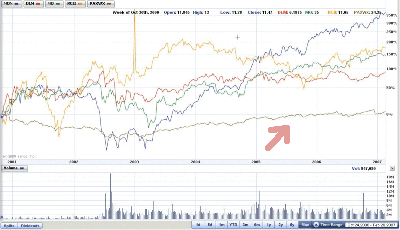Since last January, we have put forth the Satan’s Portfolio theory of investing (see related series of articles Satan’s Portfolio), which follows this:
Ethical and socially responsible investing has made a lot of buzz as a way of dollar voting for a better world. My instinct as an investor says that those fund flows are going the wrong way and their returns since inception back up my argument.
The more profitable questions to answer are: What does Satan invest in? How does he fund evil? Satan’s Portfolio will track the perfomance of the stocks which Mephistocles is proud to put his money into, namely, companies who benefit from suffering, death, war, tobacco, nutrasweet and fraud.
Today’s WSJ has an article (Sub required) which states that the PAX fund, the negative model for Satan’s Portfolio, is going to look to put more sin into its sinvesting:
Now, Pax wants to tone down that objective. Shareholders in August were sent a proxy statement to vote on whether to eliminate a zero-tolerance policy specifically against alcohol and gambling. The change would enable Pax to selectively invest in these industries based on a company’s “entire social-responsibility profile.”
But in other areas, the fund is trying to add new ways to screen out companies it might disapprove of. Shareholders will also vote on whether fund managers should consider a company’s record on environmental issues, for instance.
These shifts illustrate how SRI funds are trying to tweak their strategies amid sagging returns. SRI investors are sometimes willing to exchange a few points of returns for socially conscious stock picking.
…
By contrast, funds like Vice Fund — which actively seeks out sin stocks — have handily beaten most SRI funds recently. In the past three years, Vice Fund has posted a 20% average annual return.
A host of other SRI funds are also fiddling with their approaches. In December, Domini Social Investments LLC will abandon its traditional approach of passively tracking an index of socially responsible companies in its Domini Social Equity Fund, and instead will become an actively managed fund, picking its own stocks to invest in. Last year, it launched a new fund, Domini European Social Equity Fund, which was actively managed from the start. In May TIAA-CREF, the teacher’s-pension giant, announced the formation of a new social and community investing department, and Ariel Capital Management LLC started Ariel Focus Fund last year.
Recommendation: We expect Socially Responsible Investment funds to continue to be forced by their meager returns to invite more and more sin into their portfolio, but at that point, what’s the point of social investing? It either is or is not socially responsible. “Kinda” Socially Responsible Investment funds just leaves a fund with poor returns and doesn’t have the value of making your Democrat friends applaud your refined sense of social responsibility.
Hat tip to Dealbreaker.com.
 Private Equity shops are primarily known for their ability to take public equity markets (or unwieldy conglomerates) in one hand and squeeze the coal out of them to create diamonds, while in the other hand, taking the leveraged loan market and squeezing it to get super-low cost debt financing out of it, and then riding off into the Billionaire Sunset…or onto their mega-yachts. But sometimes their tactics are much more base and straightforward than spotting a good deal and getting it done.
Private Equity shops are primarily known for their ability to take public equity markets (or unwieldy conglomerates) in one hand and squeeze the coal out of them to create diamonds, while in the other hand, taking the leveraged loan market and squeezing it to get super-low cost debt financing out of it, and then riding off into the Billionaire Sunset…or onto their mega-yachts. But sometimes their tactics are much more base and straightforward than spotting a good deal and getting it done. 
 Susan Solovay, a woman by trade, has started a fund of funds whose mandate will be to invest only in hedge funds run by women. Solovay is marketing this FoF on the claim that women manage investments better than men. (quotes from
Susan Solovay, a woman by trade, has started a fund of funds whose mandate will be to invest only in hedge funds run by women. Solovay is marketing this FoF on the claim that women manage investments better than men. (quotes from